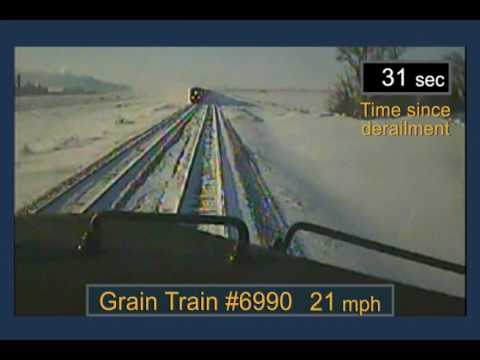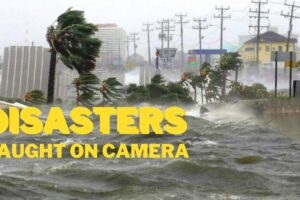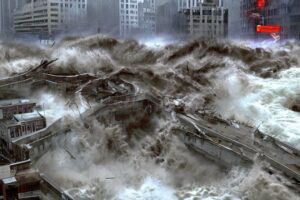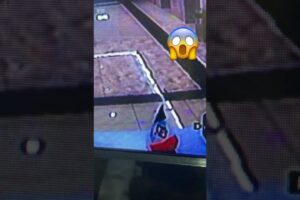
To read the full report follow the link below:
https://www.ntsb.gov/investigations/pages/casselton_nd.aspx
Casselton, North Dakota
December 30, 2013
DCA14MR004
The video comes from the forward-facing on-board image recorders from the two trains involved in the accident. Video from the Grain Train lead locomotive 6990 was downloaded from the undamaged GE Lococam on-board image recorder. Parametric data from the Grain Train lead locomotive 6990 was downloaded from the undamaged event recorder. Video from the Crude Oil Train lead locomotive 4934 was obtained from data transmitted wirelessly when the emergency brakes were applied, and parametric data was downloaded from the trailing distributed power unit locomotive 6684.
The video begins at 14:08:37 Central Standard Time (CST) with the view from the front of the Grain Train as it travels westbound on main track 1. The text “Grain Train #6990” and the speed of the train are displayed at the bottom center of the screen. The westbound direction of travel is briefly indicated by a text annotation. The train passes a track switch and a vehicle belonging to a signal maintainer at 14:09:06; the vehicle is labeled by a text annotation for about 10 seconds as the train approaches the vehicle. The front end of the crude oil train begins to be visible on the adjacent track to the left at about 14:09:41, and it is labeled with a text annotation. The derailment of the Grain Train occurs at 14:09:57, after which time a digital counter is shown on the right in the image, indicating the time in seconds since the derailment. A text annotation indicates that the emergency brakes on the Grain Train were applied at 14:10:13, uncommanded by the train crew. At 14:10:33, the lead locomotive of the Crude Oil Train passes the lead locomotive of the Grain Train.
At 14:11:02, the video switches to the view from the front of the Crude Oil Train as it travels eastbound on main track 2. The text “Crude Oil Train #4934” and the speed of the train are displayed at the bottom center of the screen. The eastbound direction of travel is briefly indicated by a text annotation. A text annotation indicates an engineer-induced emergency brake application on the Crude Oil Train occurred at 14:11:03. A
text annotation also points out the 45th car in the Grain Train, which is fouling main track 2. The Crude Oil Train strikes the 45th car in the Grain Train at 14:11:12, leading to derailment of the Crude Oil Train, which departs main track 2 to the right and apparently comes to rest once impacting the built-up ballast supporting a parallel set of railroad tracks.
The video includes an audio overlay of radio traffic broadcast over radio channel 70, with communications from the Grain Train, the Crude Oil Train, the dispatcher and the signal maintainer passed by the Grain Train at 14:09:06. The audio begins with a call from the signal maintainer to the crew of the Grain Train at 14:10:31, and ends at 14:11:59 after the crew of the Crude Oil Train have reported the derailment and subsequent fire to the dispatcher.
source







OH MY GOD!!!!!!!!!!!!!!!!!!!!!!!!!
"…Call me as soon as you can, Earl."
Damn look how far that locomotives went in the snow b.
I can see a freight car derail and the camara got to the oil train the driver apply the brake and it was to late the train derail a jump the track the driver said their is a fire in train
No more head end dashcams after this,jeez wonder why?
Don’t do durgs kids :/
I'm more confused than a black kid on father's day.
Oops
Lol
That is the (BNSF KO Subdivision) coming out of Moorhead Minnesota to the east of there as it comes off the (BNSF Staples Subdivision) to Minot North Dakota where it merges with the (Canadian Pacific Portal Subdivision) from Harvey North Dakota to northwest of North Portal Saskatchewan, and the (Glasgow Subdivision) from Minot North Dakota to Glasgow Montana.
(subdivisions and rail companies in parenthesis)
Never good news when the train takes a dirt road.
This is what happens to crude trains. Never to well-mannered trains.
Good thing #4934 pulled the brake; hitting that car at 43 m.p.h. would have been devastating!
As Stobe the Hobo would have said, “that’s FNBS.”
OOF 2:40
Derailment on a straight track. That's me walking and chewing gun at the same time.
We are everywhere.
Nani? Multi track drifting!?
what took the crew of 6990 so damn long to acknowledge that they were in emergency and warn the other train ?
It's like watching a train wreck.
What are the chances?? That must've been one hell of a ride. (Literally)
IS NOBODY GONNA TALK ABOUT HOW THE TRAIN YEETED OF THE TRACKS?!
In case you didn't know im pretty sure this is the casselton train derailment
Which train is everywhere? "4-9-3-4 WE ARE EVERYWHERE"
Okay uh 4934 is everywhere, ok call me when you get there… "We are all over, we gotta go"
I would love to continue to watch 6990's front camera after 4934 derails.
well the train didnt like the track so it went to another one
the engineer's don't wave from the trains anymore;not like they did back in 1954; iguess they could back then i know there were fewer derailments. too many trains in such a rush times back then were much slower a pace.
It is never a good thing when you look out the locomotive front windscreen and there is no track there.
All of you making fun of this are immature assholes.i bet if you were the guy saying we are everwheir you smart assholes wouldn't be laffing
Where is the crash audio from the impact of the 4934 smashing into the derailed grain car?
Bruh.
The train derails at 1:25
So horrible that bnsf 48665’s axel fell off and damaged/burned 4934 and the engine behind it beyond repair. I have Ryan’s Colorado Productions to thank for the information.